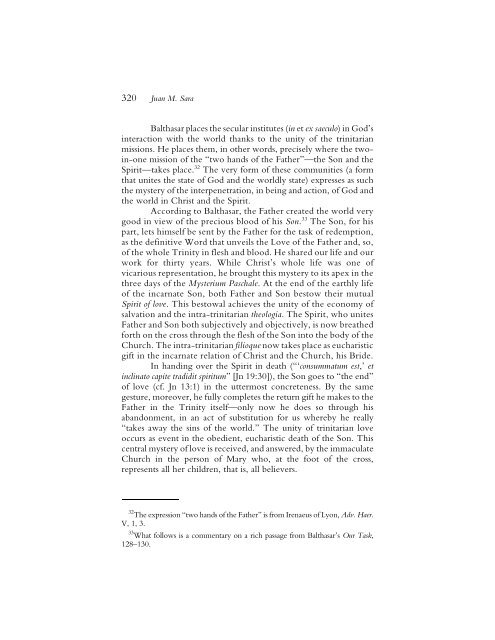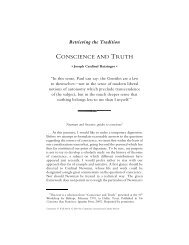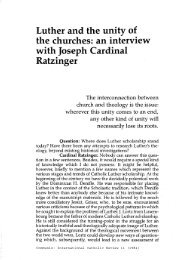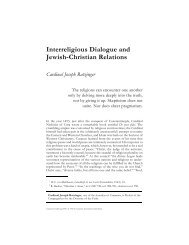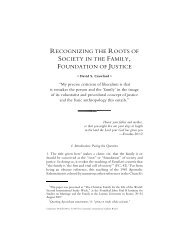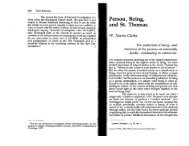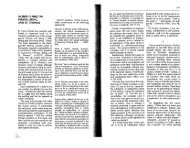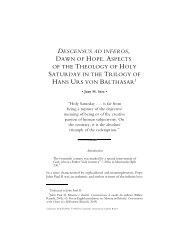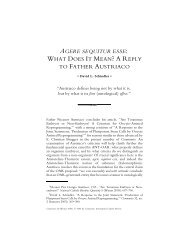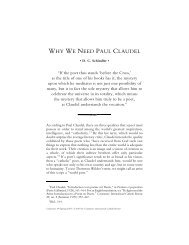Juan Sara. Secular Institutes According to Hans Urs ... - Communio
Juan Sara. Secular Institutes According to Hans Urs ... - Communio
Juan Sara. Secular Institutes According to Hans Urs ... - Communio
Create successful ePaper yourself
Turn your PDF publications into a flip-book with our unique Google optimized e-Paper software.
320 <strong>Juan</strong> M. <strong>Sara</strong><br />
Balthasar places the secular institutes (in et ex saeculo) in God’s<br />
interaction with the world thanks <strong>to</strong> the unity of the trinitarian<br />
missions. He places them, in other words, precisely where the twoin-one<br />
mission of the “two hands of the Father”—the Son and the<br />
Spirit—takes place. 32 The very form of these communities (a form<br />
that unites the state of God and the worldly state) expresses as such<br />
the mystery of the interpenetration, in being and action, of God and<br />
the world in Christ and the Spirit.<br />
<strong>According</strong> <strong>to</strong> Balthasar, the Father created the world very<br />
good in view of the precious blood of his Son. 33 The Son, for his<br />
part, lets himself be sent by the Father for the task of redemption,<br />
as the definitive Word that unveils the Love of the Father and, so,<br />
of the whole Trinity in flesh and blood. He shared our life and our<br />
work for thirty years. While Christ’s whole life was one of<br />
vicarious representation, he brought this mystery <strong>to</strong> its apex in the<br />
three days of the Mysterium Paschale. At the end of the earthly life<br />
of the incarnate Son, both Father and Son bes<strong>to</strong>w their mutual<br />
Spirit of love. This bes<strong>to</strong>wal achieves the unity of the economy of<br />
salvation and the intra-trinitarian theologia. The Spirit, who unites<br />
Father and Son both subjectively and objectively, is now breathed<br />
forth on the cross through the flesh of the Son in<strong>to</strong> the body of the<br />
Church. The intra-trinitarian filioque now takes place as eucharistic<br />
gift in the incarnate relation of Christ and the Church, his Bride.<br />
In handing over the Spirit in death (“‘consummatum est,’ et<br />
inclina<strong>to</strong> capite tradidit spiritum” [Jn 19:30]), the Son goes <strong>to</strong> “the end”<br />
of love (cf. Jn 13:1) in the uttermost concreteness. By the same<br />
gesture, moreover, he fully completes the return gift he makes <strong>to</strong> the<br />
Father in the Trinity itself—only now he does so through his<br />
abandonment, in an act of substitution for us whereby he really<br />
“takes away the sins of the world.” The unity of trinitarian love<br />
occurs as event in the obedient, eucharistic death of the Son. This<br />
central mystery of love is received, and answered, by the immaculate<br />
Church in the person of Mary who, at the foot of the cross,<br />
represents all her children, that is, all believers.<br />
32<br />
The expression “two hands of the Father” is from Irenaeus of Lyon, Adv. Haer.<br />
V, 1, 3.<br />
33<br />
What follows is a commentary on a rich passage from Balthasar’s Our Task,<br />
128–130.


